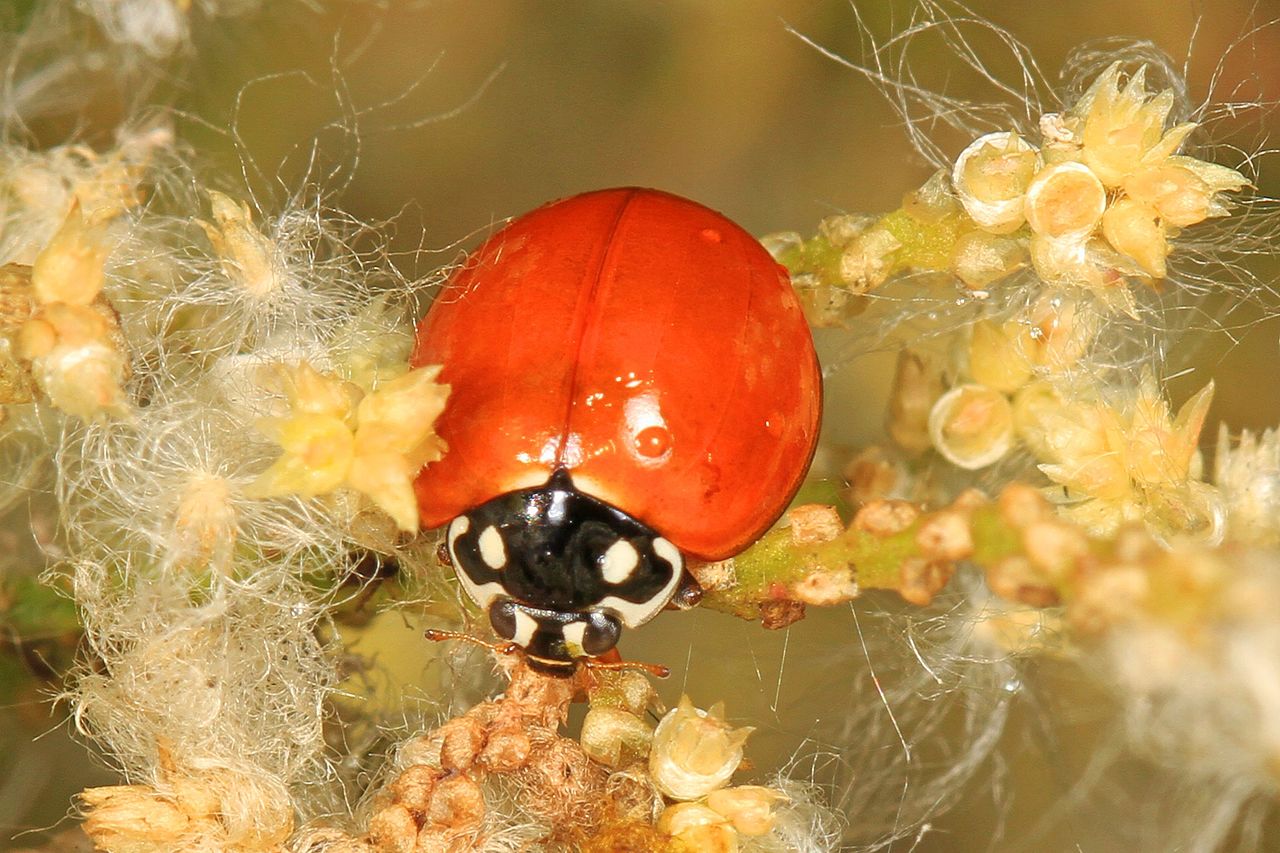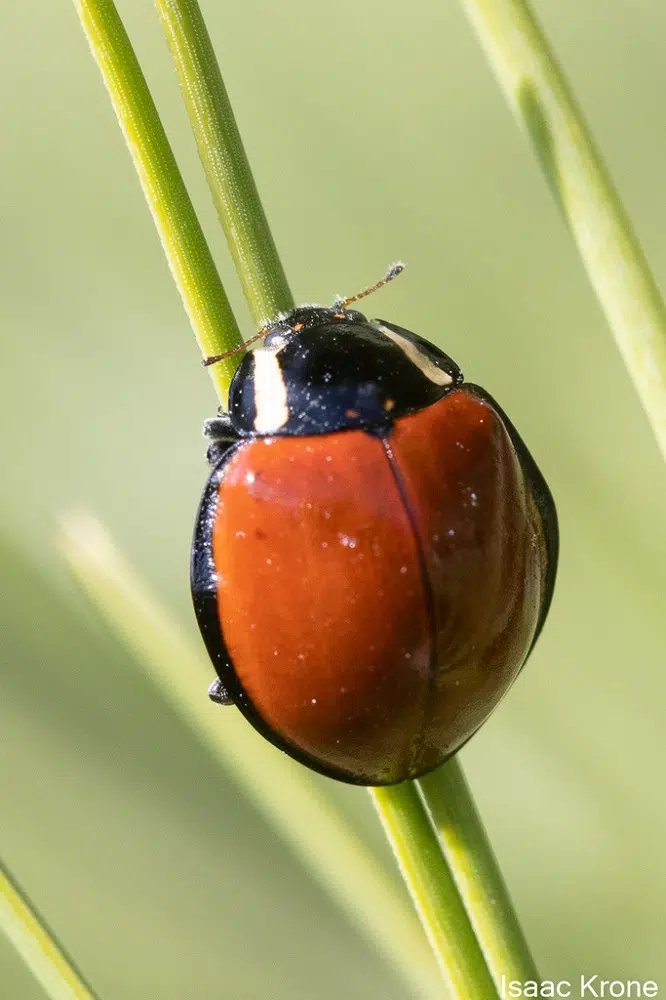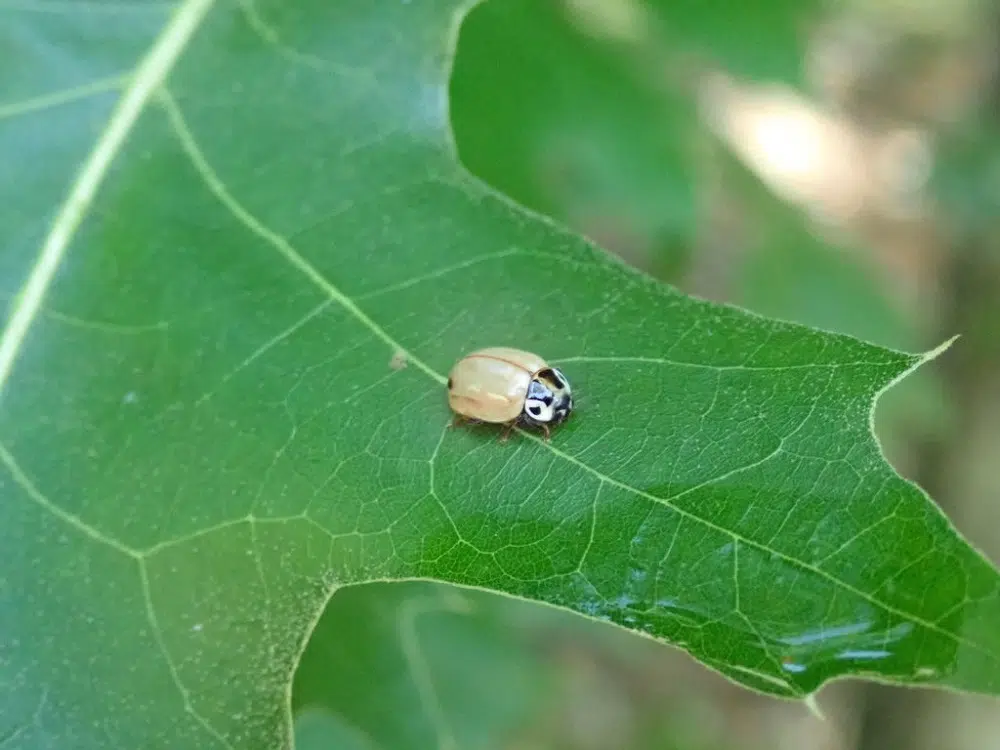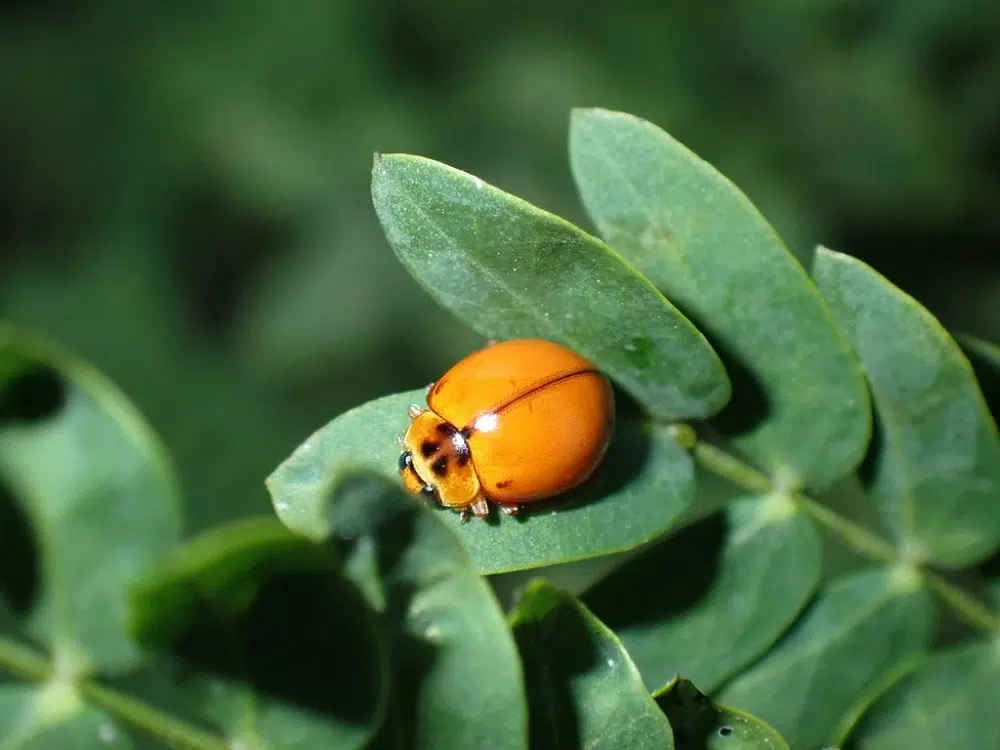Ladybugs without spots are found in North America and around the world.
They come with spotless elytra which can have various colors.
Spotless ladybugs might still have small spots, mostly on the head as these marks sometimes help differentiate male and female ladybugs.
Various species of ladybugs without spots are used as predators to control bug populations in agriculture or gardening.
Some spotless ladybugs are native to North America while others have been introduced (mainly from Asia and Oceania) to control excessive bug pest populations on crops.
All of these bugs are small. Most of them measure around 5mm. Only the largest ladybugs without spots measure up to 10mm.
Table of Contents
Are There Ladybugs Without Spots?
There are numerous types of ladybugs without spots. A lack of spots on the elytra isn’t rare in ladybugs as there are more than 5.000 ladybug species.
Most ladybugs are associated with led elytra with black spots. However, there are a few common types of ladybugs that don’t have any spots at all or that only have spots on the head.
Introduced species
North America is home to both native and introduced species of ladybugs without spots.
They are found in Southern states when introduced from tropical climates or in most states when introduced from temperate climates.
Larch ladybirds are an example of a ladybug without spots that have been introduced to North America to control aphids
Native species
There are also native species of ladybugs without spots in North America.
Western Polished ladybugs are an example species of ladybugs without spots native to North America.
Types of Ladybugs Without Spots
The following species are most common in warm and temperate climates.
1. Spotless Ladybug

The Spotless Ladybug (Cycloneda sanguinea) is one of the most common species with no marks on the elytra, as its name suggests.
These ladybugs have red or orange-red elytra that are rich in color and slightly black on the edges.
This makes the bulk of the body lack any black, brown, or white markings.
Black is the dominant color of the head. The pronotum is mostly black with some white marks. The white marks differ from male Spotless ladybugs to female Spotelss ladybugs.
The black coloring continues down to the face for females while males have a whiter face by comparison.
This species can appear brown when seen in a shaded spot and red when out in the sun. I
2. Polished Ladybug

This ladybug species (Cycloneda munda) is also mostly spotless. Its elytra or its back are orange-brown without any spots.
This makes the Polished ladybug look more like a roach than a ladybug in color.
Subtle differences between males and females are seen in the Polished ladybug as in the Spotless ladybug.
For example, the black and white head looks different in females compared to males.
Males have a white face with small lateral black markings. Females have a black head with smaller white markings.
3. California Ladybug

The California Ladybug (Coccinella californica) is mostly found on the West Coast. It grows to a maximum size of 5.7mm and it’s characterized by a red body without spots.
The spotless ladybug has a red shiny body and black and white elytra.
Its red color is more vivid in most habitats but it may also appear red-brown in some morphs.
4. Western Polished Ladybug

The spotless Western Polished Ladybug (Cycloneda polita) is native to North America. The species has mostly red elytra.
Black is the dominant color of the head and thorax. This species grows to an average of 5mm and it’s identified by a white rim around the head.
This white rim is characteristic of both males and females.
5. Metallic Blue Ladybug

The species (Curinus coeruleus) has a metallic dark blue spotless elytra. It’s further characterized by a dark blue head with 2 orange markings on it.
Metallic Blue ladybugs aren’t native to North America. They are an introduced species, mainly for the control of various pest bugs.
These spotless ladybugs eat scale insects and aphids that feed on citruses.
Introduced from Mexico, this species is most common in tropical and sub-tropical regions.
Its preference for very warm climates means the Metallic Blue Ladybug is only found in Southern Florida.
It’s here that the introduced species help control plant lice.
6. LeConte’s Giant Ladybug

This brown Ladybug (Anatis lecontei) is also spotless. It’s one of the largest ladybugs in North America growing to a size of 10.5mm.
It has a black pronotum with a black head and yellow lines on its head.
The species is only seen on trees in woodlands. It feeds on aphids.
7. Steelblue Ladybug

The Steelblue Ladybug (Halmus chalybeus) is dominated by a spotless metallic blue body and a similarly-colored thorax.
It grows to an average size of 3-4 mm and it’s an introduced species in many parts of the world.
These ladybugs mostly feed on scale insects.
Ladybugs of this genus are mostly found in the Northern states. However, their natural habitat is increasing.
Steelblue ladybugs are a known predator of Southern invasive bugs such as the San Jose scale.
This invasive scale was introduced in the US from China through the area of San Jose.
8. Streaked Ladybug

The Streaked Ladybug (Myzia pullata) is a native North American species. It comes in multiple morphs, all of them without spots.
Ladybugs of this genus are either brown, yellow, or red. They have black heads with yellow markings.
Streaked ladybugs are solitary bugs, mostly seen on trees in woodlands.
These ladybugs are rare sights and even considered endangered in many states.
9. Yellow Ladybird Beetle

The Yellow Ladybird Beetle (Illeis koebelei) is a vivid yellow species. It has yellow spotless elytra and a white spotted head.
There are 2 black spots on its white head.
Part of the Coccinellidae family, this ladybeetle is known for its selective diet as it only feeds on aphids.
10. Larch Ladybug

Larch Ladybugs (Aphidecta obliterata) are prevalent in temperate climates. They have a spotless tan to brown elytra and a white head with black marks.
This species lives in woodlands. It prefers pine woodlands at high altitudes.
Larch ladybugs might also be seen in the winter as they prefer to overwinter in the bark of the same trees they populate in the summer.
Larch ladybugs are an introduced species with a few known sub-species in North America.
It’s found in a higher number of species in Europe, where it has also been introduced to control plant lice.
11. Discolored Ladybug

Discolored Ladybugs (Micraspis discolor) are common in Asia and Oceania. They get their name from their pale orange-red body.
These ladybugs have a tan-brown head with black spots. Only the elytra are spotless.
Ladybugs of this genus grow to a size between 5 and 6mm.
Discolored ladybugs are mostly seen in the spring. They are most common in rice fields.
Why Are There Ladybugs Without Spots?
Ladybugs without spots evolved to the same protective coloring as ladybugs with spots. However, many spotless ladybugs are better adapted to the environment.
To blend in with the environment
Spotless ladybugs come in different colors from bright red to brown. Many orange, brown, and yellow ladybugs can easily blend in with the plants and flowers they are seen on.
Some brown ladybugs that live in forests on pine trees are also harder to spot compared to spotted ladybugs.
Not all spotless ladybugs blend in with the environment as many stand out in nature. Red spotless elytra ladybugs are among the species that easily stand out in their habitat. This doesn’t stop them from being good predators as they have good flying skills.
To ward off predators
One of the main reasons ladybugs have spotless elytra is to keep predators away.
While not perceived as poisonous as spotted ladybugs, spotless ladybugs are still vividly colored which scares off potential predators.
Birds are one of the most common ladybug predators.
Some birds can be scared by the colors of spotless ladybugs.
Some of the brightest colors deter birds the most. Metallic blue, green, yellow, and red are among the colors spotless ladybugs have that keep most birds away.
Are Ladybugs Without Spots Poisonous?
Ladybugs without spots are not poisonous. Many predators assume these ladybugs are poisonous.
Apart from bad taste, spotless ladybugs are not known for having any poison.
They have a specific diet such as aphids or other bugs and they live as far as possible from predators.
Spiritual Meanings of Ladybugs Without Spots
The spiritual meaning of ladybugs without spots has rarely been disconnected from the spiritual meaning of ladybugs with spots.
Both types of ladybugs have various beliefs associated with them.
These beliefs are based on the dominating color. In this case, this is the color of the elytra.
Ladybugs without spots mostly come with a different color for the head and legs.
But the elytra is the biggest and most visible part of the bug and it’s tied to different spiritual meanings.
Good luck
Ladybugs are mostly associated with good luck. Red spotless ladybugs such as the Spotless ladybug (Cycloneda sanguinea) are mostly associated with good luck.
The spiritual meaning of good luck is tied to some type of blessing or unexpected good fortune.
You can expect to have good luck or to facilitate good luck events for someone else whenever you see red spotless ladybugs.
Success in finances
Financial success is one of the most important aspects of personal well-being.
Ladybugs without spots are often seen as some of the most emblematic when it comes to being tied to financial success.
These ladybugs don’t have spots of a different color which means yellow or green spotless ladybugs can be tied to expected financial success.
High energy
Yellow ladybugs without spots are tied to youth and high energy. These are some of the most common types of ladybugs.
Yellow ladybugs without spots can also have a white head. This is the case of the Yellow Ladybird Beetle (Illeis koebelei).
Yellow ladybugs are known to attract high energy or a feeling of revitalization.
Ladybugs without spots are known for flying long distances looking for food such as food lice, aphids, and other bugs.
This means they naturally have high levels of energy.
Protection
Protection is tied to brown ladybugs without spots.
Brown or tan ladybugs without spots are mostly associated with a feeling of protection for their diet as well.
These bugs can eat detrimental invasive aphids, which offer them a tangible protective feeling.
Protection has also been tied to black ladybugs without spots.
Both brown and black ladybugs without spots are either seen as a sign you need protection from some events or people or that others around you need help in protection.
Creativity
Yellow is the color of creativity. All yellow-dominant ladybugs are associated with feelings of creativity, planning, and execution.
A person is expected to embark on new projects, often by using creative means whenever seeing one of these ladybugs without spots.
Gentleness
Spotless ladybugs are perceived as more gentle than spotted ladybugs.
The spots on the elytra are often seen as poisonous while the spotless elytra are seen as more gentle and friendly.
Ladybugs are some of the friendliest species of bugs and spotless ladybugs are dominant in this category.
This is why they are often seen as ideal cartoon characters and why children love them so much.
Summary
Ladybugs without spots are found in North America as native or introduced species.
They control aphids and scale insects.
These are 2 common types of sucking insects. Together with mealybugs, aphids and scales have a detrimental role in agriculture.
They suck the plant and flower sap creating economic damage.
Ladybugs without spots are introduced specie for the control of pest bugs as well as native species found in North America.
Some of them have a restricted habitat, mainly due to their temperature preferences.
Ladybugs without spots from the Caribbean or Central America around found in Southern states.
Species introduced from temperate climates might be found all around the country.